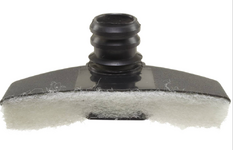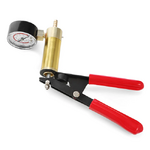69427
The Artist formerly known as Turbo84
- Joined
- Mar 30, 2008
- Messages
- 3,077
- Reaction score
- 38
At the track day last week the brakes were fantastic when first applied coming up to the corner. If I did a quick second application of the brakes there seemed to be little to no deceleration going on. The pedal was high and firm at both the first and second application. It just felt like a typical power brake system that has no vacuum to the booster. The throttle was closed through all this, so the booster should be getting vacuum to the front side of the diaphram. So, I'm confused on what's going on here. Booster is an '84 C4 unit.
Another possibility I was trying to figure out if the master cylinder was the culprit. It was hot to to the touch, and slightly overfilled. I drained out some fluid to reduce the vertical pressure column under braking, just in case the cylinder "ram" couldn't release the fluid quick enough under braking. (Far fetched, but I was really scratching my head trying to figure out the cause). I also tie strapped a length of foam tubing insulation onto the master cylinder to reduce the heat conduction, but didn't see any improvements. The master cylinder is a C5 aluminum part.
Another item I'm addressing is the vacuum tubing between the booster and the carb. I changed the vacuum plumbing over the winter, and for all I know I might have possibly caused this problem. I have two sources of vacuum (the carb base at the secondaries, and a manifold fitting right at the #8 cylinder runner). I also have two main requirements for vacuum: The brake booster and the PCV vailve. I used to plumb them to the two vacuum ports I mentioned, but I always hated that the port above #8 runner either injested oily fumes from the PCV valve, or injested raw air from the booster that leaned out #8 cylinder. So, over the winter I hooked the booster hose and the PCV hose together at a tee about 1.5" behind the carb base fitting. I figured that I shouldn't get a noticeable pressure rise (vacuum loss) over that short of a distance. But, I can be wrong, and maybe that was the cause of the vacuum booster acting odd. I don't know. Either way, I am now making a way to pull vacuum straight from the manifold plenum, and I will hook the PCV hose to that, and the card vacuum post will hook to the booster.
That;s where I'm at. I welcome comments and advice on this issue.
Another possibility I was trying to figure out if the master cylinder was the culprit. It was hot to to the touch, and slightly overfilled. I drained out some fluid to reduce the vertical pressure column under braking, just in case the cylinder "ram" couldn't release the fluid quick enough under braking. (Far fetched, but I was really scratching my head trying to figure out the cause). I also tie strapped a length of foam tubing insulation onto the master cylinder to reduce the heat conduction, but didn't see any improvements. The master cylinder is a C5 aluminum part.
Another item I'm addressing is the vacuum tubing between the booster and the carb. I changed the vacuum plumbing over the winter, and for all I know I might have possibly caused this problem. I have two sources of vacuum (the carb base at the secondaries, and a manifold fitting right at the #8 cylinder runner). I also have two main requirements for vacuum: The brake booster and the PCV vailve. I used to plumb them to the two vacuum ports I mentioned, but I always hated that the port above #8 runner either injested oily fumes from the PCV valve, or injested raw air from the booster that leaned out #8 cylinder. So, over the winter I hooked the booster hose and the PCV hose together at a tee about 1.5" behind the carb base fitting. I figured that I shouldn't get a noticeable pressure rise (vacuum loss) over that short of a distance. But, I can be wrong, and maybe that was the cause of the vacuum booster acting odd. I don't know. Either way, I am now making a way to pull vacuum straight from the manifold plenum, and I will hook the PCV hose to that, and the card vacuum post will hook to the booster.
That;s where I'm at. I welcome comments and advice on this issue.



